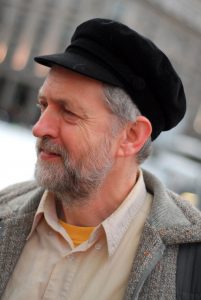 He has been accused of looking like a secondary school geography teacher. But inside and outside parliament Corbyn puts a downbeat emphasis on policy, and rejects the Punch and Judy politics of Westminster.
He has been accused of looking like a secondary school geography teacher. But inside and outside parliament Corbyn puts a downbeat emphasis on policy, and rejects the Punch and Judy politics of Westminster.
By Dave Westacott [Deutsche Version]
The results of the latest election for the leadership of the British Labour Party will be announced at the party’s annual conference in Liverpool on Saturday, 24 September. It is the second such election in a year. And it is one that Jeremy Corbyn, the sitting leader, is widely expected to win again, possibly even with an increased majority.
And that is despite the opposition and abuse from more than three-quarters of his own MPs, despite constant denigration in the media, and despite shameless attempts by the Labour central machine to disenfranchise suspected Corbyn supporters on the flimsiest pretexts.
But why did it come to this? And what is the phenomenon that not only elected the surprise left-wing candidate in the first place, but has led to a massive increase in Labour Party membership? With over 500,000 full members it is now the currently biggest party in Europe. Over 200,000 of those members joined since Corbyn became leader last year.
Of the main factors have contributed to Corbyn’s ascent, one was the increasingly obvious bankruptcy of “Blairism” – the modern-day, neoliberal variant of right-wing social democracy that has dominated the Labour Party and most European social democratic parties since the 1980s.
Another is the change in the election system for the Labour leadership. Paradoxically, this was introduced primarily by the right wing itself in an attempt to limit the influence of the increasingly left-leaning trade unions. And it has now spectacularly exploded in their faces.
It’s worth knowing something about the history of the Labour Party to understand this. Unlike other European social democratic parties, the Labour Party was set up by the unions, not vice versa. From 1900 to 1918 it did not even have individual membership.
Until 1980 the leadership was elected at by conference itself, where the union delegates, as on all other issues, had the so-called “block vote” both for the leadership as well as for the general policy of the party. This meant the unions cast a vote in proportion to their membership (of millions), and their decisions on who or what to vote for were meant to be decided by their own internal democratic procedures.
As long as the union leaders largely supported the right wing – even when they were blatantly ignoring the views of their members – this was not a problem. Only when major unions began to support somewhat more left-wing policies and candidates, but also as the party leadership shifted even further to the right, did this become a focus for attack from the right inside and outside the party.
In 1980, the system was changed to an electoral college, with voting split one third union, one third constituency members, and one third MPs and MEPs. The conference itself was completely undermined and downgraded as little more than an orchestrated media event.
After Labour lost power in 2010, the leadership embarked on another round of supposed “democratisation”. With advisers from the US Democratic party, it was suggested to broaden the franchise, as in US primaries, include non-party members in the selection process and put an end to the electoral college and the union block vote.
Surprisingly, the unions, even the now moderately left-wing engineering and general union Unite, agreed with this. From now on it would be one person one vote. The unions would no longer have a block vote, but in addition to full Labour Party members in the constituencies all members of affiliated unions who wanted to be associate members of the party would have a vote (at a reduced membership fee of £3). And there would be a new category of “registered supporters” who would also have a vote.
What could possibly go wrong? The right-wing leadership that introduced these changes firmly believed that it would weaken union influence, and that the new, broader membership would carry on supporting the supposed “modernisers”.
What went wrong first was that Ed Milliband, running with “Blairism lite” policies, lost the 2015 general election and immediately resigned. The leadership candidates who lined up to replace him were all from the same intake that had dominated the Labour Party for the previous 20 years. Career politicians and lawyers, promoted under Blair, whose entire political creed was based on finding the “centre ground” and not upsetting media barons such as Rupert Murdoch.
Corbyn only got onto the ballot because no one else in the the small left group in the parliamentary Labour Party (PLP) thought they could run. His reaction was: “I suppose it’s my turn.” It was only with the last-minute support of a few MPs who would never actually vote for him that he got the 35 nominations necessary to contend.
But it soon became clear that the right had miscalculated. They had no “grass roots” and the majority of members had become heartily sick of the years of Blairism and its successors.
Corbyn went on to win with a landslide majority with just under 60 per cent, winning all sections of the party except the PLP. A decisive moment was when the interim leader, Harriet Harman, decided Labour MPs should abstain on the government’s welfare reform bill, because it might “look bad” in the media to oppose some of the measures in a bill that was essentially about attacking some of the poorest people in society.
Corbyn was the only leadership candidate who had voted against it. In particular, the other candidates were also discredited by their support for the Iraq war. Corbyn on the other hand, as a former chair of the Stop the War Coalition and leading member of the Palestine Solidarity Campaign was one of the most prominent opponents of the war from the start.
In just his one year in leadership he has now shifted centre of gravity of the whole political debate in Britain. He has focused on poverty, inequality, the shortage of affordable housing, low pay, zero hours contracts and the disappearance of well-paid jobs for the working class. Asked if, as prime minister, he would in any circumstances give the order to launch Britain’s submarine-based nuclear missiles, he simply said “No”.
Unlike previous leaders and his opponents in the PLP, the has also made it quite clear he is for the renationalisation of the railways. Until now, although opinion polls have shown overwhelming support for the reversal of that disastrous privatisation, no other Labour leader has dared to unequivocally call for it.
Now his opponents in the PLP say that it is not his policies but his personality that is the problem: he is an honest, decent person, but he is unelectable. But these are people who never accepted him from the start and would do anything to undermine him. And there is every reason to suspect that their real nightmare would be the prospect of him actually winning.
It was only a question of time and tactics as to when and how they moved against him.
They saw the Brexit vote as their opportunity, blaming Corbyn for the leave vote, and saying he had not campaigned strongly enough to remain. He was known as a longstanding opponent of the the EU, but on this occasion, as party leader, he argued for remaining and reforming, though famously responding to a question by saying he was only 7 out of 10 for the EU.
But the attempted coup has only served to anger large numbers of Labour members who saw the MPs attempting every means to overturn a massive democratic mandate. And that was Corbyn’s defence when the MPs tried to bully him into standing down.
The coup started with a series of staged resignations from the shadow cabinet almost at hourly intervals to ensure maximum media coverage. This was followed by a meeting of the PLP in Westminster where there was a (non-binding) vote of no confidence and a chain of MPs berating Corbyn as ineffectual and demanding he resign, while reporting all this to the press pack outside.
As supporters such as the MP Dianne Abbot said at the time, the coup organisers hoped they could break him psychologically and force him to step down without a contest. But they failed. Remarkably he stood firm, and simply said he could not betray the trust of all the members who had voted for him.
The next step was to attempt to stop him from even getting on the ballot, by insisting he needed the minimum number of MP nominations to stand, even though he was the sitting leader. That was overturned in court. What was not overturned was the cut-off time, preventing anybody who had registered as a supporter after January 2016 from voting (unless they could pay an extra £25 within a very short time).
Despite all this, it still looks like Corbyn may win again. He has been speaking to packed halls and rallies of thousands up and down the country in towns where no other politician draws such crowds. And he is not even charismatic and the audiences are often not traditional Labour supporters. He will be 69 by the next general election, and has been accused of looking like a secondary school geography teacher. But inside and outside parliament he puts a downbeat emphasis on policy, and rejects the Punch and Judy politics of Westminster. But that is part of his success.
The question is what happens next, if as it seems he is re-elected. The problem of the existing hostile MPs remains. But for some of them reselection will not be a choice but an inevitability when nationwide administrative changes to the constituency boundaries come into force next year.
A key for the future is the organisation of the many new members and Corbyn supporters, both in the “Momentum” pro-Corbyn pressure group and in the party as a whole.
Of course, Momentum has been accused of being another Trotskyist entryist group like “Militant” in the 1980s. But there are simply not that number of Trotskyists in Britain. The people who are coming and coming back to Labour are mainly composed both of returning older members disillusioned during the Blair years and a mass of young people who were previously not politically involved.
The important organisational things that Corbyn has promised include giving democratic decision-making about party policy back to the members – to the party conference. Second, using the capacity of Momentum to build a dedicated task force of campaigners that can mobilise throughout the country.
They have already shown their ability in the use of social media to get the message across despite the hostility of the mainstream media, and they have learned much from the experience of the Bernie Sanders’ campaign in America
There have naturally also been comparisons to organisations such as Podemos. But the difference is that this concerns an existing workers’ party, and that the movement for change is still closely supported by the trade unions.
Above all, as Corbyn and his supporters emphasise, it goes well beyond Corbyn himself. Labour remains a social-democratic party, although one that with great difficulty is attempting to throw off the sickness of right-wing opportunism.
Now it is no longer about winning office for Labour as an end itself, which only leads to enormous disappointment and disillusion, but about making genuine progress. And at root it is about is about taking back a movement for its members – or even truly taking it for the first time.
Dave Westacott, a British communist, member of the Party of Labour of Austria, currently living in Vienna
Foto: David Martyn Hunt (flickr.com; Lizenz: CC BY 2.0), Titelbild: The People Speak (flickr.com; Lizenz: CC BY 2.0)




